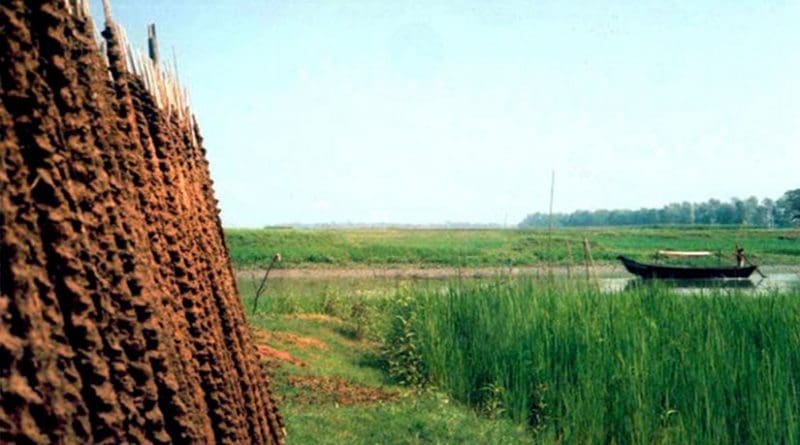Managing The India-Bangladesh Border – Analysis
By IPCS
By Dr Joyeeta Bhattacharjee*
India and Bangladesh border management cooperation got a major boost following the meeting between the directors general (DGs) of India’s Border Security Force (BSF) and Border Guards Bangladesh (BGB). The meeting, 47th in the series of dialogues between the top commanders of India and Bangladesh’s border guarding forces, took place in Delhi in early September. The meeting provided an opportunity for free and frank discussions on various issues concerning management of the common borders and contributed to a better understanding of each other’s stance. The meeting was a reassurance Indian and Bangladeshi commitments to further enhance cooperation on border management.
BGB chief Major General Md Shafeenul Islam led a 13-member delegation from Bangladesh for the meeting. An equal number of officials led by BSF Director General KK Sharma represented India. The two sides sought each other’s cooperation in tackling a wide variety of issues. The priority issues for India were preventing cross-border attacks by criminal gangs on BSF personnel, joint efforts to prevent trans-border crimes, action against Indian Insurgent Groups (IIGs), border infrastructure, joint efforts for effective implementation of the Comprehensive Border Management Plan, simultaneous coordinated patrolling, identification of vulnerable areas, sharing of information, and confidence-building measures. For Bangladesh, the important issues were trans-border crimes, smuggling of various types of drugs/narcotics, arrests/apprehension of Bangladeshi nationals, expansion of crime free zones, etc.
The meeting of the BSF and BGB DGs was instituted in 1975 and it is a crucial border management security cooperation mechanism between the two countries. India and Bangladesh share a 4096 km-long porous border, thus making it vulnerable to various transnational crimes like smuggling of arms, narcotics, fake currency and human trafficking. Besides, the porous border has encouraged cross-border networks of insurgent and militant groups, threatening the security of both countries. India and Bangladesh thus realise that cooperation is necessary to tackle challenges at the border.
The DG-level meetings have hitherto played a constructive role in the growth of cooperation on border management between India and Bangladesh. For example, India introduced non-lethal weapons at the Bangladesh border following an agreement signed by the two in 2010 in order to reduce deaths of Bangladeshis at the border.. The move has not only been helpful in reducing Bangladeshi deaths but has also contributed to building trust between the troops and among the people of Bangladesh, for whom these deaths at the border often evokes anti-India emotions. The sustained dialogue has contributed in the deepening of confidence amongst the two forces. Today, there is willingness on the both sides to listen to each other’s concerns and to work jointly in addressing challenges. The Coordinated Border Management Plan signed in 2011 between India and Bangladesh to check trans-border illegal activities and crimes highlights this cooperative approach.
As suggested by the outcomes of the meeting, the recent meeting emphasised the principle of cooperation. To address concerns over the death of Bangladeshis at the border and the attack on BSF personnel by Bangladeshi criminals, the two agreed to take preventive actions to stop criminals/offenders from crossing the international border. They agreed to take measures to prevent illegal border crossing and trafficking and to facilitate early rescue and rehabilitation of the victims as per the law of the land. In addition, India and Bangladesh agreed to take legal measures against those who wilfully violate the international border so that they are tried according to the laws of the respective countries, and the inadvertent crossers are handed over to the concerned border guarding force immediately. Further, the meeting approved various pending border developmental works – a priority for India.
Considering the success of the crime-free zone established in the southern Bengal frontier, the two sides agreed to set up similar zones in other frontiers. Stressing the need for joint action to check cross-border criminal activities like smuggling of fake Indian currency and narcotics from India to Bangladesh, both pledged to continue the cooperation.
Responding to India’s request to eliminate the remnants of IIGs, the BGB chief said that there are no IIG hideouts in Bangladesh. He, however, assured that his country will not allow its soil to be used by any entities or elements hostile to any country. Earlier, Bangladesh had acted against the IIGs that were operating from its territory, which was a turning point for the India-Bangladesh bilateral relationship.
The DG meeting reviewed the state of cooperation on border management and gave necessary direction for the growth of cooperation. It provided a major impetus to sustain the momentum for continuing bilateral cooperation on border management.
*Dr Joyeeta Bhattacharjee is a Senior Fellow with the Neighbourhood Regional Studies Initiative, Observer Research Foundation (ORF). All views are the author’s own.

